2 虚拟地理环境教育部重点实验室(南京师范大学), 江苏 南京 210023;
3 江苏省地理信息资源开发与利用协同创新中心, 江苏 南京 210023)
“4.2 ka事件”发生在4.2 ka B.P.和3.9 ka B.P.之间,是全新世快速降温事件之一[1~3]。在过去的十年中,越来越多的高分辨率地质记录对该事件进行了详细描述,在“4.2ka事件”气候变化的对比和机制研究方面发挥重要作用。泥炭、孢粉以及黄土[4~6]等记录显示,由于不同的地理位置和不同的气候系统,此次降温事件在北半球中、低纬度大部分地区表现为干旱的气候状况[7~11],而在北半球高纬度地区和南半球部分地区则以潮湿的气候条件为主[12~13]。印度东北部Mawmluh洞石笋δ 18O序列是目前关于此事件最高分辨率的记录,标定其持续时间为4.2~3.9kaB.P.,显示该时段印度夏季风(Indian Summer Monsoon,简称ISM)呈现“干旱-湿润-干旱”三级结构变化[14],但是在东亚季风区“4.2ka事件”的结构尚不明确。同时,关于“4.2ka事件”的成因机制仍存争议,究竟是北大西洋的海洋-大气环流变化有关还是与太阳活动有关未下定论[15~16]。最近,江西神农洞石笋研究发现在4.55kaB.P.左右时,北大西洋经向翻转流(the Atlantic Meridional Overturning Circulation,简称AMOC)处于非常弱的阶段,引起亚洲夏季风(Asian Summer Monsoon,简称ASM)减弱以及季风雨带向南移动,从而导致中国中南部形成干旱的气候,支持北大西洋驱动的论调[17]。“4.2ka事件”在不同记录中结构和气候模式方面的差异,以及该事件机制的争议,需要我们寻找高分辨率地质载体,如石笋,来重建并深入探讨该气候突变事件。
研究显示,洞穴石笋δ 18O记录主要反映了不同时间尺度上的亚洲夏季风(ASM)演化,因这些变化与全球气候密切联系、有区域意义,因此得到最为广泛地应用[18~22]。但是,我们在关注氧同位素的同时,还应重视石笋碳同位素、灰度、微量元素等其他代用指标对古环境重建的补充作用[23~26]。因为这些元素和石笋沉积特征的变化也能反映表层岩溶带的气候环境和水文地质条件的变化[27~29]。例如,轨道尺度上δ 13C反映与降雨量大小相关的植被覆盖率变化[30]。中国南方丰鱼洞65kaB.P.以来石笋δ 13C与δ 18O记录在千年尺度上呈现出基本一致的变化,反映了植被覆盖率变化对干旱事件的响应[31]。泰国西北部石笋灰度研究显示,灰度值越高,δ 18O值越偏负,指出灰度值可以作为指示降雨的代用指标[32]。中国黑风洞石笋研究表明灰度可以指示全新世东亚夏季风演化历史[33]。此外,观测研究表明,洞穴水文环境状况(如温度、有效降水)和方解石沉积等相关过程都会影响微量元素浓度[34~35]。降水量和方解石先期沉积(Prior Calcite Precipitation,简称PCP)经常用于解释滴水和洞穴中Sr/Ca和Ba/Ca的协同变化[36~38]。由于基岩化学成分、地下水运动、土壤厚度和气候条件的差异,洞穴中的微量元素含量与气候条件之间的联系可能因洞穴而异,因此微量元素多反映局地气候与洞穴水文特征。
本文基于湖北利川市玉龙洞石笋,获取包括δ 18O、δ 13C、灰度和微量元素在内的不同代用指标记录,重建全新世高分辨率东亚季风演化序列,讨论多指标的环境意义,并进一步探寻全新世气候变化的突变事件,如“4.2ka事件”的气候特征。
1 样品和方法石笋样品(TCL)采自玉龙洞(30°39′N,109°13′E;海拔为1273.5m)(图 1)。该洞地处湖北省恩施土家族苗族自治州利川市团堡镇,属典型亚热带季风气候区;冬季寒冷,夏季湿热,年平均气温在12.6℃左右,年降雨量为1460mm[39]。玉龙洞洞穴系统分为一个主洞3个支洞,主洞最高处80m,最宽处40m,最窄处0.6m,3个支洞呈左一右二排布于主洞两侧,全长1630m。洞内终年恒温14~18℃,相对湿度接近100 %。TCL石笋采自洞穴深处,受外界环境影响较小,有利于保存古气候变化信息。
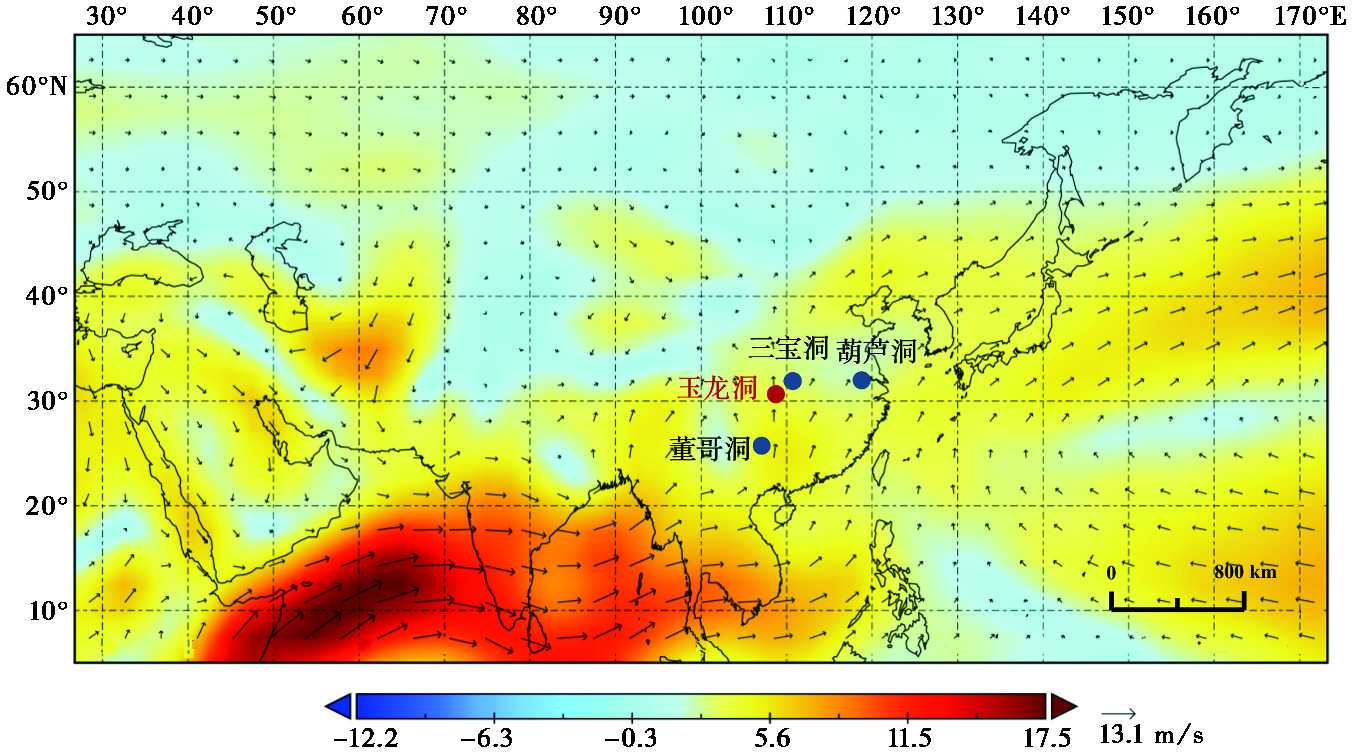
|
图 1 湖北玉龙洞及本文引用其他洞穴地理位置示意图 底图为6~8月850 hPa风场图(1950~2010年),图中的箭头代表空气流动方向和风速,数据来源于NCEP/NCAR再分析数据(http://www.esrl.noaa.gov/psd) Fig. 1 Location of the Yulong Cave and other caves referred in this paper. The base map is the 850 hPa wind field diagram from June to August(from 1950 to 2010). The arrows indicate the direction of air flow and their wind speed. These are based on the NCEP/NCAR reanalysis datasets |
石笋样品长约400mm,顶部直径60mm,底部直径90mm,呈圆柱状。石笋切开抛光后,发现其生长轴未发生较大偏移,表明滴水中心基本稳定(图 2)。石笋样品没有明显沉积间断,岩性均一,主要由白色的致密方解石组成,夹杂黄色粘土条带,条带分别位于53~60mm、160~170mm、270~280mm、305mm和325mm深度。
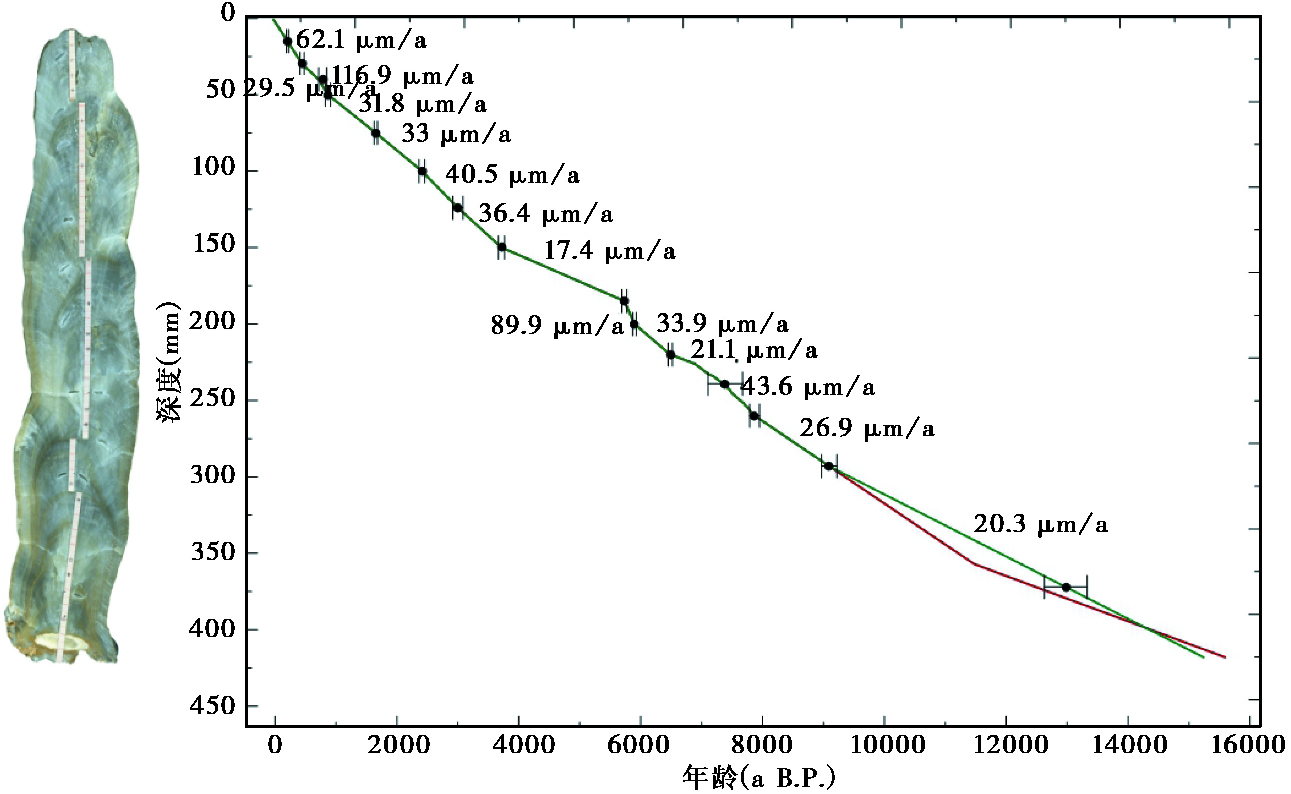
|
图 2 玉龙洞TCL石笋生长速率、年龄模式与石笋形态 绿线表示测年点内插所得年龄模式;红线表示据H82[40]的YD时段调谐后的年龄模式;年龄-深度曲线附近的数字表示根据两个测年点计算的生长速率 Fig. 2 Growth rate(black)and age model(red)for sample TCL from Yulong Cave. Green line represents age model obtained by linear interpolation of dating results and red line indicates the age model after tuning to H82[40] at around YD event. The growth rate between adjacent 230Th dates are shown along with the age-depth curve with dating errors |
用直径0.9mm的碳化钢牙钻在石笋抛光面上平行于生长层钻取15个铀系年代样品,每个约为100mg。化学分离和纯化方法参照Edwards等[41],分析仪器为美国赛默飞公司生产的多接收电感耦合等离子质谱仪(MC-ICP-MS),分析方法参照Shen等[42]和Shao等[43]。测年样品TCL-30、TCL-40、TCL-50、TCL-75、TCL-150以及TCL-185由西安交通大学全球环境变化研究院同位素实验室完成,其余测年样品由南京师范大学同位素实验室完成。年龄误差为±2σ的测量统计误差,结果见表 1。
| 表 1 玉龙洞石笋TCL铀系测年结果* Table 1 U-series dating results on stalagmite TCL from Yulong Cave |
采用牙钻钻取和美工刀刮取两种方式获取石笋样品氧碳同位素测试样品。沿石笋生长轴,用直径0.5mm的碳化钢牙钻以1mm为单位钻取粉末;在2~60mm及155~165mm这两个层段,以0.2mm为间隔刮削取样进行加密,共计获得801件粉末样品。采用碳酸盐自动进样系统装置(Kiel Carbonate Device)和Finnigan公司的MAT-253质谱仪联机测试,每10个样品加测1个国际标准样品(NBS19)进行监控,由南京师范大学同位素实验室测试完成。δ 18O和δ 13C分析误差(2σ)分别优于0.06 ‰和0.05 ‰,VPDB标准。
微量元素数据利用X射线荧光光谱分析(XRF)岩芯扫描仪获取,沿轴心以0.5mm的分辨率扫描石笋,由南京大学表生地球化学教育部重点实验室完成。在扫描过程中,利用可变电压的设置,使得岩芯扫描仪在不同的电压下对不同的元素含量进行扫描分析[44]。石笋微量元素测量是石笋的灰度值采用光面测量的方法,即利用EPSON-4990扫描仪对石笋抛光面进行扫描,然后通过ENVI 4.0软件对扫描图像进行数字化处理,根据公式:灰度=0.299R+0.587G+0.114B(R、G、B分别为红、绿、蓝三要素)获得其灰度值[45]。
2 结果 2.1 时标建立TCL石笋15个230Th年龄测试结果显示(表 1),该样品238 U含量总体偏低,平均值约130 ng/g;232 Th含量在256~9839pg/g之间,接近底部的样品232 Th含量偏高,说明底部样品偏脏;总体来看,样品230Th/232 Th原子比值较小,样品年代校准偏大,尤其是TCL-372样品校正达600多年。但是大部分年龄精度较高,误差(±2σ)在100a以内,230Th年龄在误差范围内均符合生长层序。
根据铀系年龄可计算出石笋在沉积过程中的生长速率,绘制年龄-深度图(图 2),从而判别石笋在不同阶段的发育状况。石笋TCL在0~150mm层段生长速率基本一致,大部分在40μm/a左右;而在150~185mm之间生长速率最慢,仅17.4μm/a;在0~30mm、40~50mm以及185~200mm之间生长速率较快,平均超过60μm/a;200~220mm生长速率研究时段达到最大值,为89.9μm/a;220~400mm生长速率保持在20~45μm/a之间。根据所测年龄,本文利用线性内插建立时标(图 2)。在样品底部,由于新仙女木事件(Younger-Dryas,简称YD)时段附近测年样点少,年代校正和测年误差较大,依靠上下测年点内插的方法会造成时标对事件标定的偏差。因此本文参考定年精确、测试误差小且经过多次重复验证的葫芦洞H82时标[40, 46],以H82[40]序列上的YD事件开始(12.8kaB.P.)和结束(11.5kaB.P.)的时间作为调谐点,确定TCL氧同位素曲线上YD事件的起始和终止时间,再对两点间的数据进行线性内插,建立的调谐时标落在石笋测年误差范围内(图 2红实线)。结果显示,TCL石笋生长于14.4kaB.P.~2012A.D.时段。
2.2 石笋δ18O序列根据建立的时标,本文最终获取的14.4kaB.P.以来玉龙洞石笋TCL δ 18O变化序列如图 3e所示。石笋TCL δ 18O变化范围为-9.5 ‰ ~-6.6 ‰,平均值为-8.48 ‰。石笋TCL δ 18O曲线在整体趋势上服从65°N 7月21日的太阳辐射量的变化[47](图 3e),继而根据该记录所体现的变化特征,将其演变划分为5个阶段:1)突变阶段(14.4~11.4kaB.P.):在此期间δ 18O曲线有3次突变,分别是在14kaB.P.大幅度负偏,随后,δ 18O在13kaB.P.时开始正偏,在12kaB.P.达到低谷后迅速偏负至-8.7 ‰,整个时段对应于末次冰消期中晚期,这一过程维持了近600a;2)缓变阶段(11.4~9.8kaB.P.):此期间δ 18O值在突变的基础上由-8.7 ‰缓慢偏负到-9.3 ‰,进入全新世鼎盛期;3)平稳波动阶段(9.8~5.7kaB.P.):δ 18O围绕平均值-9.2 ‰上下波动,除8.2kaB.P.存在δ 18O值正偏外,其余时段振幅均较小,且整体负偏于全新世的平均水平(-8.5 ‰),这一阶段大致对应于全新世大暖期[48];4)缓慢偏正阶段(5.7~0.9kaB.P.):δ 18O曲线呈现出高频振荡的阶梯式偏正趋势,同位素值振幅达3 ‰左右,叠加了众多千年-百年尺度的次级振荡,且δ 18O在5.2kaB.P.、4.4kaB.P.以及1kaB.P.存在3处明显正偏,分别大致对应于“5.2ka事件”、“4.2ka事件”和“1ka事件”[49];5)偏负阶段(900aB.P.~2012A.D.):近1000年来,δ 18O在-7.1 ‰的基础上缓慢负偏,振幅达1.5 ‰。
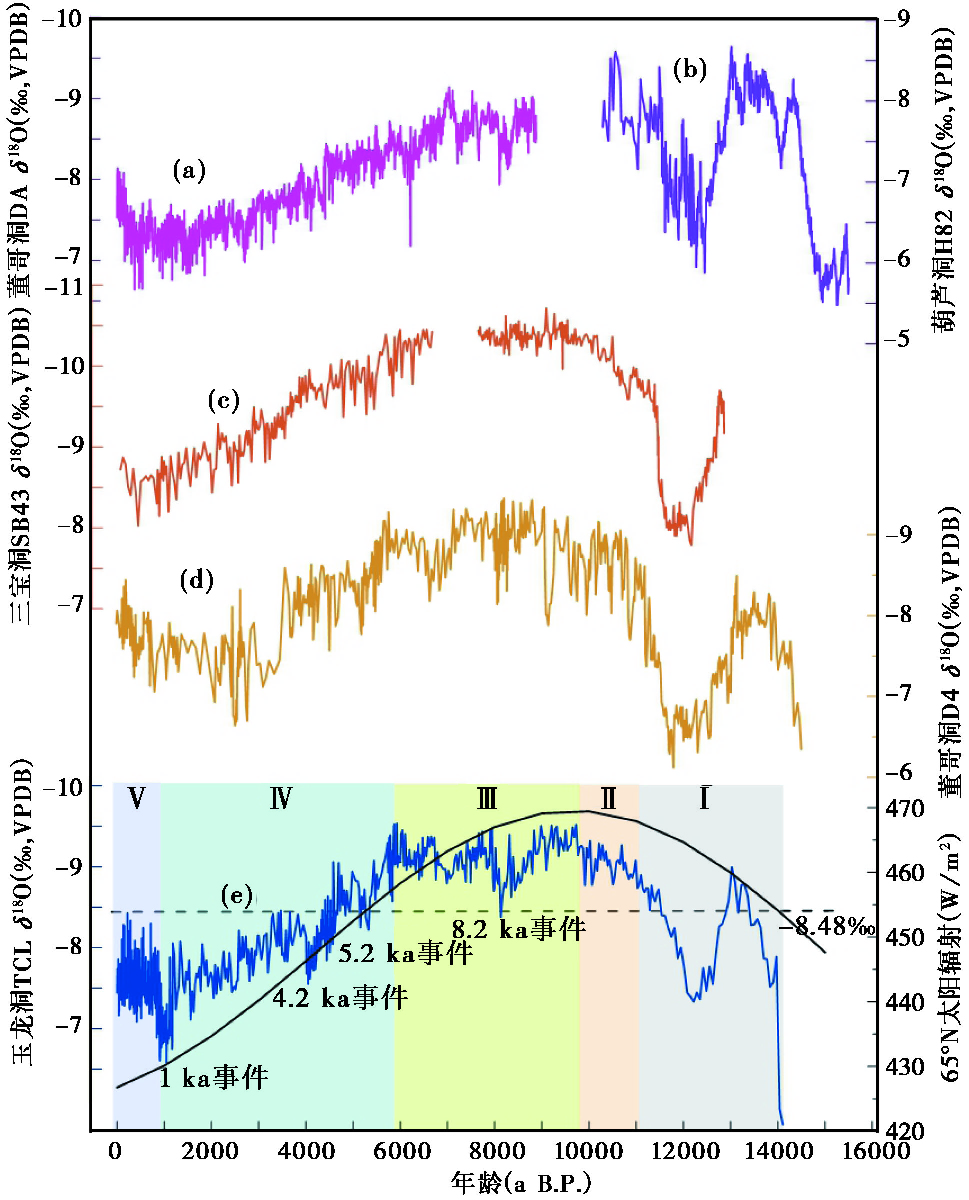
|
图 3 玉龙洞TCL石笋δ 18O序列与其他记录的对比 (a)董哥洞DA石笋δ 18O记录[50];(b)葫芦洞H82石笋δ 18O记录[40];(c)三宝洞SB43石笋δ 18O记录[51];(d)董哥洞D4石笋δ 18O记录[52];(e)玉龙洞TCL石笋δ 18O记录,另外,黑色实线表示65°N7月21日太阳辐射[47]阴影表示δ 18O曲线变化的5个阶段(Ⅰ~Ⅴ);虚线表示整个时段内δ 18O平均值 Fig. 3 Comparison between the Yulong Cave δ 18O record(e, this study)and δ 18O records from other caves in China. Dongge Cave[50, 52](a and d), Hulu Cave[40] (b) and Sanbao Cave[51] (c). The black line indicates solar insolation on 21 July at 65°N in figure(e)[47]. Bars indicate five stages (Ⅰ~Ⅴ)of the TCL δ 18O profile changes and the dashed line indicates the average of δ 18O values |
在运用石笋δ 18O作为气候代用指标之前,需要检验δ 18O是否达到同位素平衡分馏。沿生长轴方向,对石笋氧碳同位素样点进行线性回归分析,结果显示,同位素之间的相关系数R仅为0.038(图 4a),表明石笋所有样点的氧碳同位素均不相关。同时在TCL石笋抛光面上选取5个相对清晰的生长层,每层以1mm为间距自石笋生长轴心分别向两侧取两个样品进行氧同位素分析,结果显示,同一生长层上的氧同位素变化较小(图 4b),其中在190mm、230mm和250mm处的标准偏差在0.1 ‰左右,175mm和215mm的标准差约为0.2 ‰。以上测试表明石笋TCL受到动力分馏影响较弱,基本达到同位素平衡分馏[53]。
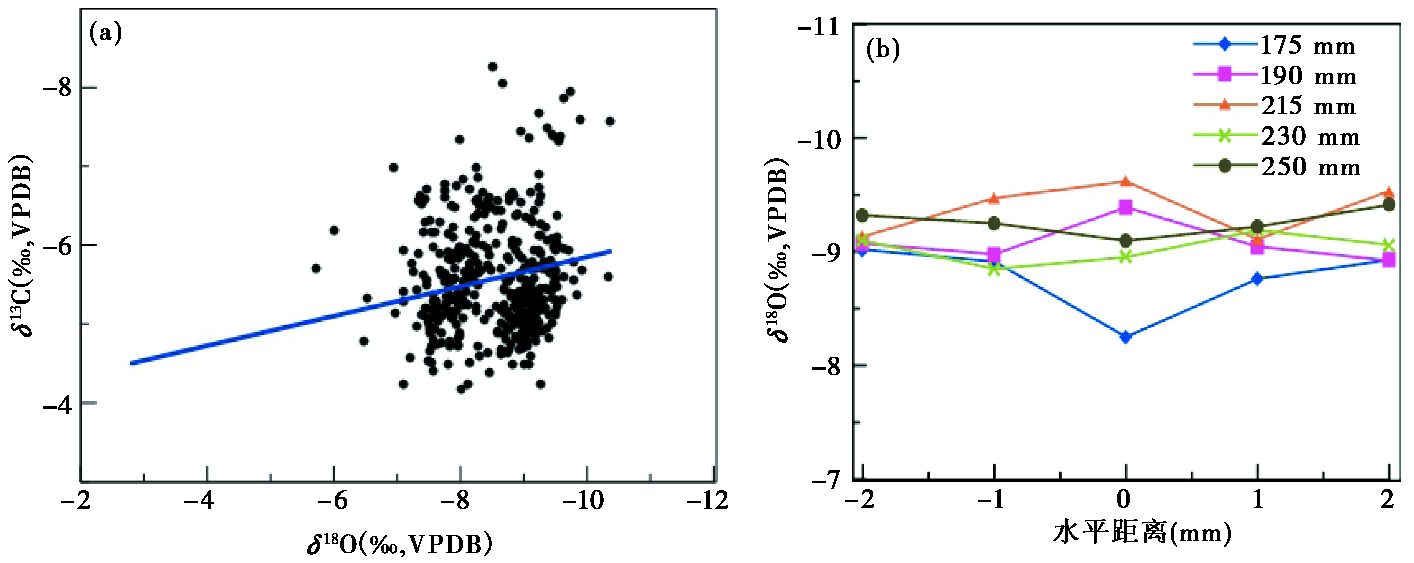
|
图 4 石笋TCL同位素平衡分馏检验 (a)氧碳同位素相关性;(b)5个深度同一生长层氧同位素数据 Fig. 4 Isotope equilibrium fractionation tese of sample TCL. (a)Correlation between the δ 18O and δ 13C values along the growth axis; (b)δ 18O data from center to edge from the same layer at different depths |
进一步将石笋TCL δ 18O记录与同时段其他洞穴的高分辨率石笋记录进行重现性检验[40, 50~52](图 3),发现自末次冰消期以来不同洞穴δ 18O记录的整体变化过程具有一致性。例如,在波令-阿勒诺德(Bølling-Allerød,简称BA)暖期,玉龙洞、葫芦洞和董哥洞石笋δ 18O值均偏轻;在12kaB.P.左右的新仙女木(YD)事件时玉龙洞、三宝洞、葫芦洞和董哥洞石笋δ 18O值偏重[40, 50~52]。在早全新世时段,不同洞穴石笋δ 18O值偏负,而在中晚全新世δ 18O值则缓慢偏正。此外,“4.2ka事件”和“8.2ka事件”[49]等次一级千年尺度波动也在不同记录中有很好的呈现。这些记录在整体与细节上的重现性指示上述区域降水均受到亚洲季风系统的影响,中国南方洞穴石笋δ 18O记录能够很好的反映亚洲季风环流特征。此外,尽管最近一两千年季风增强趋势在玉龙洞石笋记录中的发生时间与其他洞穴石笋记录[40, 50~52]有略微出入,但是都捕捉到这一重要的气候转型过程[49]。这些记录在整体与细节上的相似性与重现性表明玉龙洞石笋δ 18O达到同位素平衡分馏,能够指代气候要素的变化。
近年来,中国洞穴石笋δ 18O指标的季风强度指代意义存在较大争议,被认为反映印度季风[54]、或代表水汽源地强度变化以及水汽传输过程的变化等[55~57]。但是,不可否认的一点是洞穴滴水主要继承雨季大气降水的δ 18O变化情况[58~61],也就是说中国洞穴石笋主要记录了夏季降水δ 18O的变化特征。尽管在北半球夏季,中国南北地区降水量存在“偶极子”或“三极子”的空间差异[18],但是中国南北方记录大范围的重现性以及基本一致的演化特征表明石笋δ 18O具有区域气候意义。诸多研究表明,至少在轨道-千年尺度上,石笋δ 18O主要反映亚洲季风环流特征,包含了从水汽源到洞穴地点的综合变化结果[18, 62];而在百年及更小的时间尺度上,δ 18O影响因素更为复杂,可能包含了降水量信号,并会受到多种气候子系统的影响(如厄尔尼诺-南方涛动等)[18, 63]。模拟研究显示中国石笋δ 18O在轨道-千年尺度上可以指示季风强度[64],且中国境内的全新世湖泊记录也支持石笋δ 18O的东亚夏季风强度指代意义[65]。此外,玉龙洞附近的牛洞和三宝洞石笋研究也显示石笋δ 18O指示与季风环流相关的降水同位素成分变化[51, 66]。因此,综合上述研究结果,本文推测石笋TCL δ 18O值在轨道-千年尺度上能够反映东亚季风强度变化。
2.3 石笋其他多指标记录石笋TCL δ 13C变化范围是-8.2 ‰ ~-3.8 ‰ (图 5b),数值在以-5.4 ‰为平均值的基准线上下波动,没有长期的轨道趋势,主要存在千年尺度波动。氧碳同位素7点平滑曲线对比显示(图 5a和5b),两者的对应关系比较复杂,既有反向变化(如冰消期至早全新世段)又有同向变化(中晚全新世段):14.4~9.8kaB.P.时段,石笋δ 13C和δ 18O峰谷呈现反向变化,表现为在YD事件期间,δ 13C偏负而δ 18O偏正,而早全新世则δ 18O偏负而δ 13C偏正;而在9.8kaB.P.~2012 A.D.时段,石笋δ 18O和δ 13C峰谷基本对应,即δ 18O偏负时,δ 13C也负偏,这在千年尺度的“1ka事件”“4.2ka事件”和“8.2ka事件”上表现的十分明显。此外,δ 13C的振幅要明显大于δ 18O,约是δ 18O数值变化幅度的1.5倍,表明δ 13C对气候变化的响应更为敏感,与先前附近地区洞穴的研究结果一致[66]。
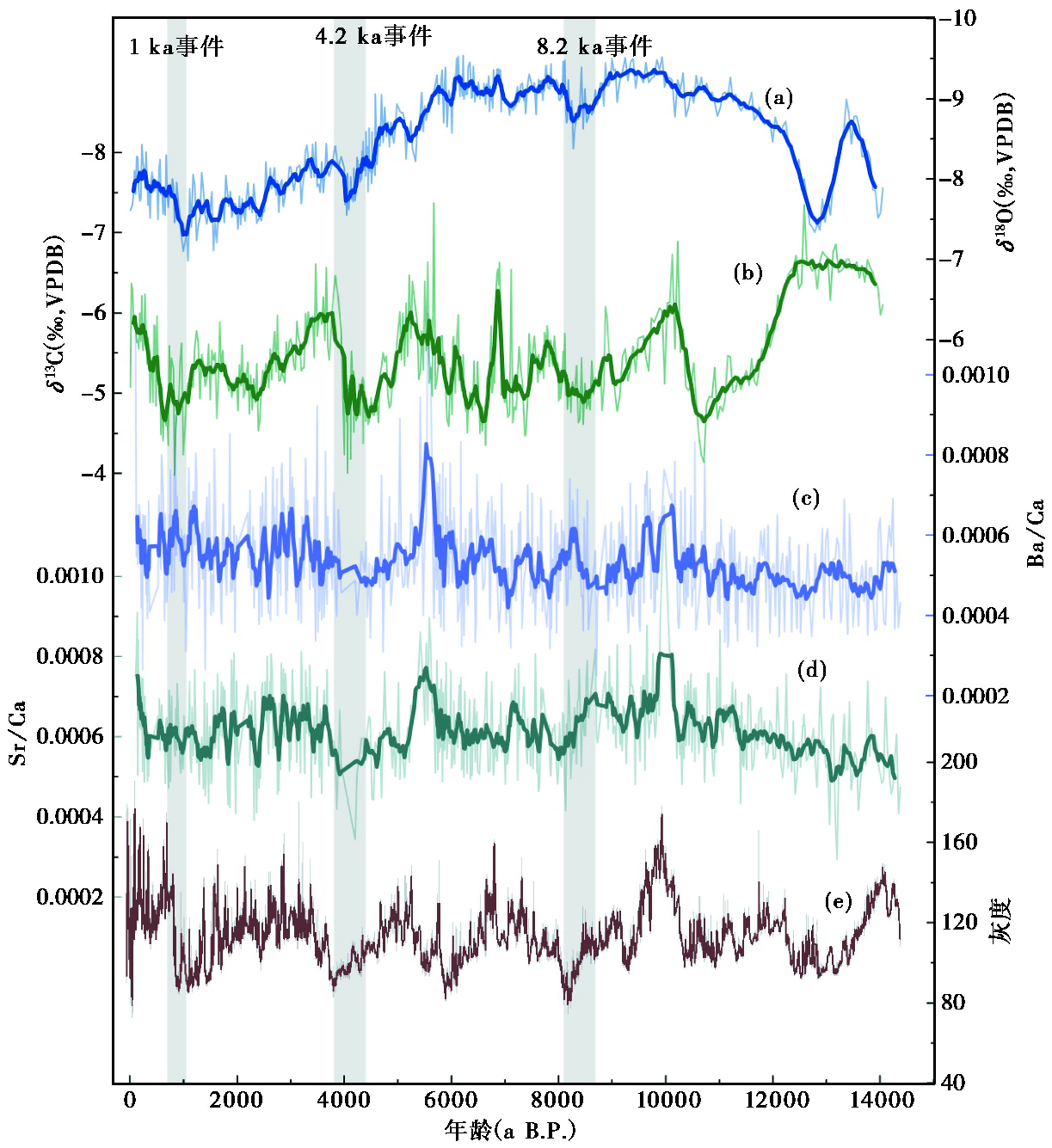
|
图 5
玉龙洞TCL石笋多指标记录对比
(a)δ 18O及7点平滑记录;(b)δ 13C及7点平滑记录;(c)Ba/Ca及7点平滑;(d)Sr/Ca及7点平滑;(e)灰度记录 灰色条带表示千年尺度弱季风事件 Fig. 5 Comparison between the multi-proxy records of sample TCL in Yulong Cave. δ 18O record and its 7-point-running mean (a), δ 13C record and its 7-point-running mean (b), 7-point running-mean in Ba/Ca (c), 7-point running-mean in Sr/Ca (d), grey level(e). The gray bars indicate the millennium-scale weak monsoon events during the Holocene |
图 5c和5d分别给出石笋Ba/Ca、Sr/Ca的微量元素比值结果。Sr/Ca数值变化介于4×10-4~10×10-4之间,Ba/Ca比值的变化范围在4×10-4~12×10-4。Ba/Ca与Sr/Ca在总体趋势和细节变化上基本一致,二者峰谷对应关系良好。如两条记录在10kaB.P.及5.6kaB.P.左右二者均检测到峰值;在冰消期至早全新世期间、8kaB.P.、7kaB.P.及4kaB.P.则存在明显低谷。此外,由于石笋TCL样品在进行XRF测试时,Mg含量较低而没有达到检测限,因此本文没有讨论Mg/Ca。
基于石笋TCL岩相获得的灰度值在70~200之间变化(图 5e)。结果显示,灰度存在一系列峰谷振荡:峰值出现在14kaB.P.、12kaB.P.、10kaB.P.、7kaB.P.、5kaB.P.、3kaB.P.和0.5kaB.P.为中心的时段,在以13kaB.P.、10.5kaB.P.、8kaB.P.、6kaB.P.、4kaB.P.以及1.5kaB.P.为中心的时段出现低谷,似乎存在约2ka的准周期。
3 讨论 3.1 多指标记录的气候意义研究表明土壤CO2是影响石笋δ 13C值的主要因素[67],而土壤CO2受控于洞穴上覆植被类型更替、植被密度、土壤微生物活动强度、生物量以及温度和降水的影响[30, 68~71]。冰期-间冰期转换引起极大的温湿度差异可能会造成C3/C4型植被的更替,由于C3型植物δ 13C值较C4型植物偏轻,因此植被更替会影响石笋的δ 13C值[30, 33, 72]。而千年尺度上土壤CO2产率主要受控于植被类型更替之外的因素。一般来说,在暖湿气候条件下,植被密度增加、微生物活动加强、植被根系呼吸作用增强等会通过提高洞穴上覆地区土壤CO2含量导致洞穴滴水δ 13C值偏轻,反之亦然;且这些过程对碳同位素的作用方向是相同的[71, 73]。研究显示,东亚季风区的石笋δ 13C记录与δ 18O记录的变化模式相似,在百年至千年尺度上存在强烈耦合关系[73~75],表明植被生长条件及土壤CO2产率受到季风环流的影响[76~77]。对比TCL氧碳同位素曲线(图 5a和5b)可以看出,全新世时段内两种指标记录千年尺度的峰谷基本对应,推测是由于季风强度引起当地水热条件发生变化,通过植被密度、微生物活动状况等变化间接对石笋δ 13C值造成影响。我们认为TCL石笋δ 13C值偏负指示气候温暖湿润状态下地表生物量大、土壤CO2生产率高;δ 13C值偏正指示气候干冷状态下地表生物量小、土壤CO2生产率低。这一结论也得到了其他研究的支持[66, 71]。
石笋灰度值反映了剖面岩相变化以及沉积物中的杂质含量,可以间接指示局地干湿度或降雨量的变化[78~81],因此可以对石笋指标的解译与古气候、古环境的重建进行补充。对比石笋TCL灰度与岩相变化发现,较高的灰度值对应于白色及浅黄色层段,即杂质层,灰度低值则对应于偏暗色透明层段,与同一地区的黑龙洞、永兴洞石笋的沉积特征一致[78, 80]。因此我们推测降水增大时,流速快的岩溶水中携带的有机质相应偏多,而偏干旱气候条件下,缓慢的洞穴滴水携带的杂质减少,反映到石笋中分别是灰度值偏高(偏低)。进一步对比发现,石笋TCL的δ 13C值和灰度对比显示出良好的相关性,偏负的δ 13C值对应于高灰度值,反之亦然;具体表现在14kaB.P.、10kaB.P.、5kaB.P.、3kaB.P.和0.5kaB.P.为附近时段的峰与峰的对应关系良好。这种类似的对应关系在以色列Soreq洞[82]和湖北黑龙洞[80]、永兴洞[78]石笋中也发现了,所以我们认为灰度值的大小间接指示了与局地干湿度或降雨量有关的洞穴水文条件的变化。值得注意的是,石笋δ 13C值以及灰度值的振荡幅度较大,并在总体变化趋势上大体一致,表明两者似乎对于环境变化更加敏感。
石笋中微量元素有众多来源,包括大气干/湿沉降、生物固定、土壤和基岩的淋滤、土壤无机组分等[36]。碳酸盐先期沉积作用(PCP)、微量元素在岩溶水运移过程中的溶解与沉淀、降水量以及降水与基岩接触时间的长短是影响微量元素含量的重要因素[36, 75],因此微量元素可以作为特定环境下局地降雨或古水文情况的有效指标[70, 83~84]。Sr和Ba主要源于上覆土壤和基岩[36],其中Ba是一种不活跃元素[85],一般在氢离子浓度偏高、pH值偏低的条件下才容易被淋滤[86]。在TCL石笋中,Sr/Ca和Ba/Ca千年尺度波动的一致性表明Sr和Ba这两种微量元素受控于相同的环境要素。将TCL石笋Sr/Ca和Ba/Ca比值7点平滑后与灰度值、δ 13C值对比(图 5),发现这4个指标的千年尺度波动对应关系良好,即微量元素比值偏高对应高灰度值和低δ 13C值,如10kaB.P.、5kaB.P.、4.2kaB.P.以及3kaB.P.的峰谷对应关系。考虑到TCL石笋灰度值反映了洞穴水文条件变化,δ 13C值反映了地表生物量情况和土壤CO2产率,我们推测Sr/Ca和Ba/Ca的主要影响因素与局地洞穴条件的变化有关。暖湿气候条件下,植被根系呼吸作用增强、有机质分解速度加快,提供了大量碳酸根离子和氢离子,使得土壤和基岩中微量元素的释放量增加,洞穴滴水中Ba2+和Sr2+的浓度加大,引起石笋中Sr/Ca和Ba/Ca值升高;反之亦然[77, 86]。此外,PCP作用对TCL石笋微量元素的影响似乎并不明显,因为按照PCP作用方式,在干旱条件下,即灰度偏小时,Sr/Ca和Ba/Ca比值应该升高[36],这与本研究数据显示的结果相反(图 5)。另有研究发现降水量影响下石笋生长速率的变化也对Sr/Ca的变化起到了重要的控制作用,生长速率加快会提高Sr/Ca,反之亦然[87]。这或许能够为TCL石笋Sr/Ca比值在5.6~4.2kaB.P.时段的大幅度下降并达到全新世最低谷值提供部分解释:从图 2可以看出该时段内石笋生长速率最慢,为17.4μm/a,说明生长速率可能会影响TCL石笋的微量元素比值。
通过石笋TCL δ 18O、δ 13C、灰度以及微量元素比值(Sr/Ca和Ba/Ca)对比(图 5)可以看出,全新世的石笋δ 18O、δ 13C值偏正对应于低灰度值和低微量元素比值,例如在8.2kaB.P.和1.0kaB.P.附近。值得一提的是,在5.6kaB.P.至4.2kaB.P.时段,δ 18O值和δ 13C值快速正偏,而灰度、Sr/Ca和Ba/Ca在此时段也有相应的大幅度变化。多种指标记录出现相同趋势的变化说明在该时段,利川地区气候环境发生了显著改变,这也进一步证实东亚季风控制下,洞穴上覆生物量与水文循环条件发生相应变化。
3.2 4.2kaB.P.弱季风事件许多古气候记录显示中晚全新世存在5个气候显著变化时期:6~5kaB.P.、4.2~3.8kaB.P.、3.5~2.5kaB.P.、1.2~1.0kaB.P.和0.6kaB.P.,这些事件具有全球性特征,特别是发生在4.2kaB.P.和2.8kaB.P.左右显著干旱的气候突变事件[88~89]。
TCL δ 18O曲线显示(图 5a),δ 18O在4.5kaB.P.左右开始发生正偏,至4.1kaB.P.结束,正偏幅度约1.5 ‰;与北大西洋冰芯记录的3号事件相对应,其持续时间段为4.3~4.0kaB.P.[49],在东亚季风区即为“4.2ka弱季风事件”。大约从5kaB.P.开始,石笋TCL δ 13C也发生持续的大幅度正偏,振幅达2.28 ‰,灰度以及微量元素代用指标均快速下降至低谷,Sr/Ca由9×10-4下降至3×10-4,Ba/Ca由12×10-4下降至3×10-4,灰度值由149下降至83(图 5e)。之后,在4.4~4.1kaB.P.时段内,δ 13C、灰度与微量元素均维持在较低水平。同时,石笋生长速率也因此达到最小值(17.4μm/a)。TCL石笋中这些不同指标出现对应“4.2ka事件”的变化,说明此时季风强度严重削弱导致利川地区环境恶化,且“4.2ka事件”似乎是对从5kaB.P.附近开始中全新世气候与环境恶化的一个持续和加强。
为了提高该时段石笋δ 18O记录的分辨率、获取内部特征,对155~165mm层段采用刮削方法加密采样,该段样品的平均分辨率可达8年。结果显示,大约在4.5kaB.P.,δ 18O开始缓慢正偏(平均值为-8.48 ‰),东亚季风强度减弱,直到4.1kaB.P.季风迅速增强,“4.2ka事件”在TCL石笋记录中整体呈现出了“缓慢进入,快速结束”的特征(图 6a)。TCL石笋记录与同一时段其他石笋记录在“4.2ka事件”的起止时间上基本一致[52, 90]。细节对比显示,土耳其北部Sofular洞So-1石笋在该时段也显示出“缓慢进入,快速结束”特征[90](图 6b);而DA石笋内部结构表现为“两谷一峰”[52](图 6c),这可能是由于记录分辨率不同使得内部结构及振荡幅度上存在一定差异。Liu等[91]发现“2.8ka事件”以及“4.2ka事件”以及其他全新世Bond事件都具有“缓慢开始,快速结束”结构特征,表明此类事件可能受控于相同的物理机制。
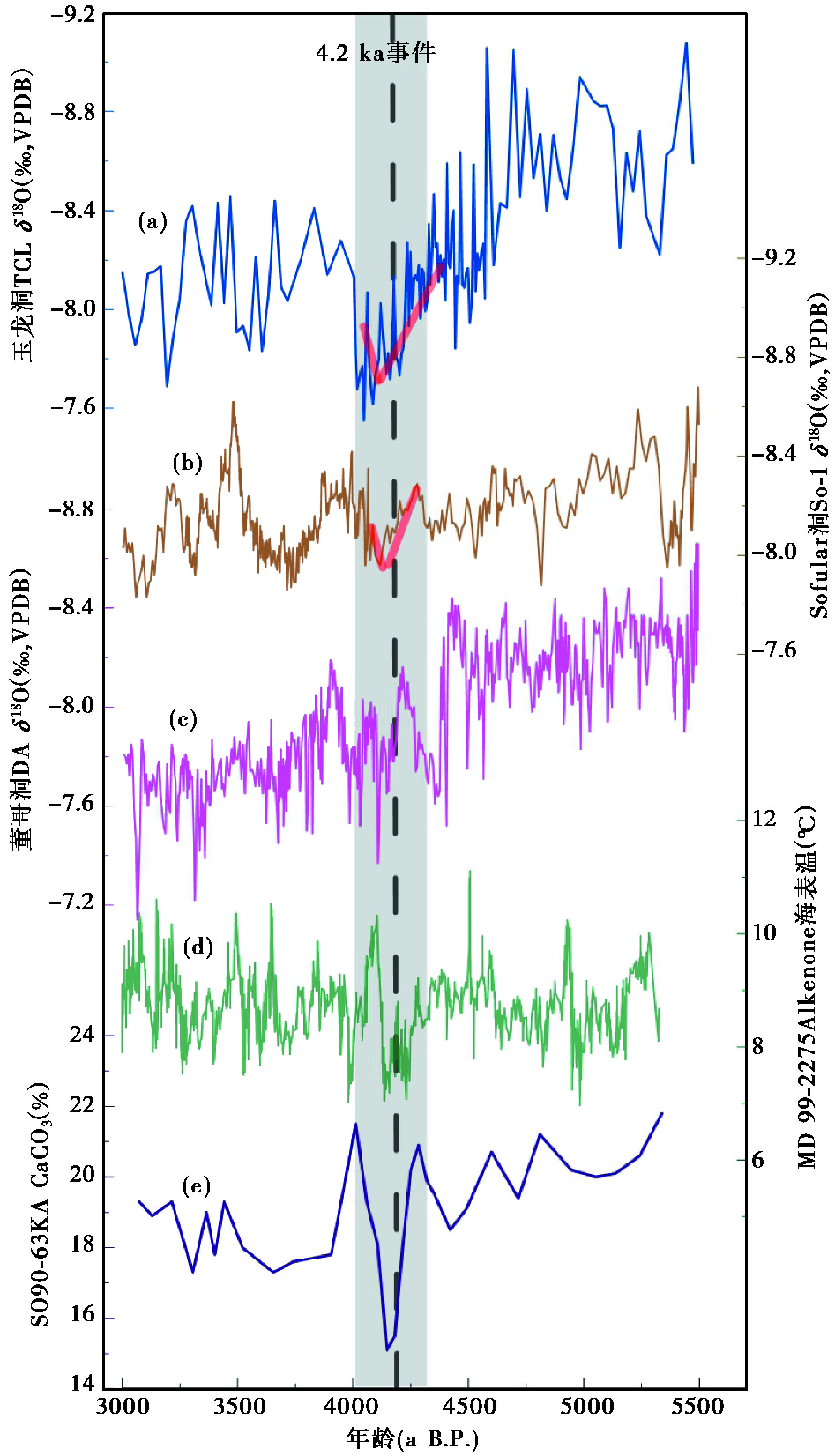
|
图 6 不同记录4.2kaB.P.事件对比 (a)玉龙洞TCL δ 18O记录(蓝色);(b)Sofular洞So-1δ 18O记录[90](褐色);(c)董哥洞DA δ 18O记录[52](桃红色);(d)冰岛北部MD99- 2275钻孔记录北大西洋海表温[93](绿色);(e)SO90-63KA钻孔CaCO3记录[94](紫色)灰色阴影棒表示“4.2ka事件”;红线指示事件变化结构 Fig. 6 Detailed comparison of 4.2ka event between Yulong Cave δ 18O record(a, blue), Sofular Cave δ 18O record(b, brown)[90], Dongge Cave δ 18O record[52](c, pink), alkenone-derived sea surface temperatures(SSTs)at the MD99-2275 core in the North Atlantic[93](d, green)and calcium carbonate content(CaCO3)of sediment core SO90-63KA[94](e, purple). The grey bar indicates the "4.2ka event". The red line indicates the structure of the "4.2ka event" |
在4.4~4.1kaB.P.时段,石笋TCL δ 13C也发生大幅度正偏,灰度以及微量元素代用指标均快速下降至低谷(图 5),说明此时季风强度较小,当地降水量减少。较少的雨量导致洞穴渗流水与基岩接触时间较长,滴率缓慢,石笋生长速率也因此达到最小值(17.4μm/a)。TCL不同指标出现对应“4.2ka事件”的变化,表明此时段利川地区环境较为干旱。
目前对于“4.2ka事件”的成因有多种解释,包括太阳活动、火山活动、北大西洋海表温、北大西洋经向翻转流(AMOC)、赤道辐合带(Intertropical Convergence Zone,简称ITCZ),欧亚大陆冰盖变化以及大气CO2浓度变化等,其触发机制仍存在争议[92]。冰岛北部钻孔MD99-2275记录显示“4.2ka事件”时,北大西洋海表温明显降低[93](图 6d)。冰漂碎屑(Ice Rafted Debris,简称IRD)记录到此时段由于大量淡水注入,北大西洋海表温(Sea Surface Temperature,简称SST)降低,使AMOC减弱,导致ITCZ向南迁移,伴随着北大西洋西风带的强度增加以及Laurentide冰川推进,进一步促使低纬度ASM减弱并形成干旱的气候环境[15, 20]。阿拉伯海东北部SO90-63KA钻孔岩芯记录中CaCO3含量在此时段呈现出低谷[94](图 6e),表明ITCZ在该时段发生南移,印度夏季风减弱,同时加强了中纬西风带,进一步导致河流径流量减少。因此本文推测“4.2ka事件”的发生是由于北大西洋快速淡水注入,AMOC减弱,北大西洋地区温度降低,半球间形成热量梯度,导致ITCZ南移,从而造成北半球中低纬度季风减弱、降水量减少并出现大面积干旱。
4 结论本文基于高分辨率和精确定年的湖北玉龙洞石笋TCL,获取了14.4kaB.P.以来包括δ 18O值、δ 13C值、灰度以及微量元素比值在内的多指标记录。结果显示,石笋TCL多种指标均显示出明显振荡特征,能够敏感地响应于气候和环境变化。主要得出以下结论:
(1) 石笋TCL δ 18O序列变化范围为-9.5 ‰ ~-6.6 ‰,平均值为-8.48 ‰,与亚洲季风区其他洞穴石笋δ 18O记录在轨道至千年尺度上表现出整体变化与细节特征的重现性,支持了亚洲地区洞穴石笋δ 18O受同一气候影响因子驱动,可以较好的反映亚洲季风强度变化的观点。石笋TCL δ 13C序列变化范围是-8.2 ‰ ~-3.8 ‰,围绕均值-5.4 ‰上下波动,且波动幅度较大,约是δ 18O数值变化幅度的1.5倍,主要反映洞穴上覆生物量以及土壤CO2产率的变化;灰度值、Sr/Ca和Ba/Ca则较好地指示了与局地水热条件相关的洞穴水文状况。此外,石笋δ 13C、灰度曲线以及微量元素比值均不存在长期的轨道趋势,但是呈现出明显的峰谷对应特征,如:表明了不同指标间具有共同的驱动机制。气候暖湿时,利川地区植被茂盛,土壤CO2产率高,石笋δ 13C值偏负,土壤和基岩中的Sr和Ba溶解并富集,同时,较多的有机质杂质伴随岩溶水沉积到石笋中,导致灰度值偏高;而当气候冷干时,生物活性受到抑制,土壤CO2产率降低,石笋δ 13C值偏正,而灰度值、Sr/Ca以及Ba/Ca则相应下降。
(2) 石笋TCL δ 18O记录了“4.2ka事件”,持续时间为4.4~4.1kaB.P.,呈现出“缓慢进入,快速结束”的结构。这一时段,石笋TCL的δ 13C也发生大幅度正偏,灰度以及微量元素代用指标均快速下降至低谷。表明此时季风减弱,区域环境条件偏干冷。对比其他地质记录显示,该时段北大西洋淡水注入且海表温降低,推测“4.2ka事件”的发生是由于AMOC减弱,ITCZ南移造成的,最终导致北半球中低纬度出现显著干冷的气候环境。
致谢: 十分感谢两位审稿专家和编辑部杨美芳老师宝贵的建设性修改意见!
| [1] |
Weiss H. Global megadrought, societal collapse and resilience at 4.2-3.9 ka B.P. across the 485 Mediterranean and West Asia[J]. Science Highlights:Climate Change and Cultural Evolution, 2016, 24(2): 62-63. |
| [2] |
Magny M, Combourieu-Nebout N, de Beaulieu J L, et al. North-south palaeohydrological contrasts in the central Mediterranean during the Holocene:Tentative synthesis and working hypotheses[J]. Climate of the Past Discussions, 2013, 9(2): 2043-2071. |
| [3] |
何鹏, 刘健, 刘斌, 等. 全新世两次典型突变事件下北半球季风降水的变化对比[J]. 第四纪研究, 2019, 39(6): 1372-1383. He Peng, Liu Jian, Liu Bin, et al. Comparison of changes of Northern Hemisphere monsoon precipitation between two typical abrupt climate events in Holocene[J]. Quaternary Sciences, 2019, 39(6): 1372-1383. |
| [4] |
谢哲宇, 裘冰倩, 肖河, 等. 东北哈尼泥炭14 ka B.P.以来大气汞沉降历史记录[J]. 第四纪研究, 2019, 39(6): 1333-1345. Xie Zheyu, Qiu Bingqian, Xiao He, et al. Study on the atmospheric mercury deposition data that retrieved from Hani peat in Northeast China since 14 ka B.P.[J]. Quaternary Sciences, 2019, 39(6): 1333-1345. |
| [5] |
许腾, 朱立平, 王君波, 等. 青藏高原北部冰前湖沉积记录的中晚全新世冰川活动[J]. 第四纪研究, 2019, 39(3): 717-730. Xu Teng, Zhu Liping, Wang Junbo, et al. Glacial activity since the mid-Late Holocene reconstructed by the proglacial Lake Buruo Co, northern Tibetan Plateau[J]. Quaternary Sciences, 2019, 39(3): 717-730. |
| [6] |
王灿, 吕厚远, 顾万发, 等. 全新世中期郑州地区古代农业的时空演变及其影响因素[J]. 第四纪研究, 2019, 39(1): 108-122. Wang Can, Lü Houyuan, Gu Wanfa, et al. Spatial-temporal evolution of agriculture and factors influencing it during the mid-Holocene in Zhengzhou area, China[J]. Quaternary Sciences, 2019, 39(1): 108-122. |
| [7] |
Finne M, Holmgren K, Sundqvist H S, et al. Climate in the Eastern Mediterranean, and adjacent regions, during the past 6000 years-A review[J]. Journal of Archaeological Science, 2011, 38(12): 3153-3173. DOI:10.1016/j.jas.2011.05.007 |
| [8] |
Migowski C, Stein M, Prasad S, et al. Holocene climate variability and cultural evolution in the Near East from the Dead Sea sedimentary record[J]. Quaternary Research, 2006, 66(3): 421-431. DOI:10.1016/j.yqres.2006.06.010 |
| [9] |
Wang H, Hong Y T, Lin Q H, et al. Response of humification degree to monsoon climate during the Holocene from the Hongyuan peat bog, eastern Tibetan Plateau[J]. Palaeogeography, Palaeoclimatology, Palaeoecology, 2010, 286(3): 171-177. |
| [10] |
Hong Y T, Hong B, Lin Q H, et al. Correlation between Indian Ocean summer monsoon and North Atlantic climate during the Holocene[J]. Earth and Planetary Science Letters, 2003, 211(3-4): 371-380. DOI:10.1016/S0012-821X(03)00207-3 |
| [11] |
David J L, Baruch S, Marion F, et al. The influence of climate, hydrology and permafrost on Holocene peat accumulation at 3500 m on the eastern Qinghai Tibetan Plateau[J]. Quaternary Science Reviews, 2009, 28(9): 3303-3314. |
| [12] |
Huang C C, Pang J L, Zha X C, et al. Extraordinary floods of 4100-4000 a B.P. recorded at the late Neolithic ruins in the Jinghe River Gorges, middle reach of the Yellow River, China[J]. Palaeogeography, Palaeoclimatology, Palaeoecology, 2010, 289(1): 1-9. |
| [13] |
Zhao Ping, Wang Bin, Liu Jiping, et al. Summer precipitation anomalies in Asia and North America induced by Eurasian non-monsoon land heating versus ENSO[J]. Scientific Reports, 2016, 6: 21346. DOI:10.1038/srep21346 |
| [14] |
Kathayat G, Cheng H, Sinha A, et al. Evaluating the timing and structure of the 4.2 ka event in the Indian summer monsoon domain from an annually resolved speleothem record from Northeast India[J]. Climate of the Past, 2018, 14(12): 1869-1879. DOI:10.5194/cp-14-1869-2018 |
| [15] |
Bond G. Persistent solar influence on North Atlantic climate during the Holocene[J]. Science, 2001, 294(5549): 2130-2136. DOI:10.1126/science.1065680 |
| [16] |
Roland T P, Caseldine C J, Charman D J, et al. Was there a "4.2 ka event" in Great Britain and Ireland?Evidence from the peatland record[J]. Quaternary Science Reviews, 2014, 83: 11-27. DOI:10.1016/j.quascirev.2013.10.024 |
| [17] |
Zhang H, Cheng H, Cai Y, et al. Hydroclimatic variations in Southeastern China during the 4.2 ka event reflected by stalagmite records[J]. Climate of the Past, 2018, 14: 1805-1817. DOI:10.5194/cp-2018-116 |
| [18] |
Zhang H, Cheng H, Cai Y, et al. Effect of precipitation seasonality on annual oxygen isotopic composition in the area of spring persistent rain in Southeastern China and its palaeoclimatic implication[J]. Climate of the Past Discussions, 2018, 1-22. DOI:10.5194/cp-2018-138 |
| [19] |
Cheng H, Edwards R L, Sinha A, et al. The Asian monsoon over the past 640, 000 years and ice age terminations[J]. Nature, 2016, 534(7609): 640-646. DOI:10.1038/nature18591 |
| [20] |
程海, 艾思本, 王先锋, 等. 中国南方石笋氧同位素记录的重要意义[J]. 第四纪研究, 2005, 25(2): 157-163. Cheng Hai, Edwards R L, Wang Xianfeng, et al. Oxygen isotope records of stalagmites from Southern China[J]. Quaternary Sciences, 2005, 25(2): 157-163. DOI:10.3321/j.issn:1001-7410.2005.02.004 |
| [21] |
黄冉, 陈朝军, 李廷勇, 等. 基于石笋记录的晚全新世太平洋东西两岸季风区气候事件对比研究[J]. 第四纪研究, 2019, 39(3): 742-754. Huang Ran, Chen Chaojun, Li Tingyong, et al. Comparison of climatic events in the Late Holocene, Based on stalagmite records from monsoon regions near by the East and West Pacific[J]. Quaternary Sciences, 2019, 39(3): 742-754. |
| [22] |
张海伟, 程海, 蔡演军, 等. 赣北石笋记录的新仙女木事件[J]. 第四纪研究, 2019, 39(4): 994-1005. Zhang Haiwei, Cheng Hai, Cai Yanjun, et al. Timing and structure of the Younger Dryas event recorded by a stalagmite from northern Jiangxi, China[J]. Quaternary Sciences, 2019, 39(4): 994-1005. |
| [23] |
程珂, 谢宇, 刘粤峰, 等. 东亚季风区石笋δ13C是否记录植被变化:从川东北石笋记录的Heinrich事件说起[J]. 第四纪研究, 2019, 39(4): 837-844. Cheng Ke, Xie Yu, Liu Yuefeng, et al. Can speleothem δ13C record vegetation changes in the East Asia summer monsoon regime?A story starting from Heinrich events recorded by speleothems from northeast Sichuan in Central China[J]. Quaternary Sciences, 2019, 39(4): 837-844. |
| [24] |
张振球, 刘殿兵, 汪永进, 等. 中全新世东亚季风年至10年际气候变率:湖北青天洞5.56-4.84 ka B.P.石笋年层厚度与地球化学证据[J]. 第四纪研究, 2014, 34(6): 1246-1255. Zhang Zhenqiu, Liu Dianbing, Wang Yongjin, et al. Annual-to decadal-scale variability of Asian monsoon climates during mid-Holocene:Evidence from proxies of annual bands and geochemical behaviors of a speleothem from 5.56 ka B.P. to 4.84 ka B.P. in Qingtian Cave, Central China[J]. Quaternary Sciences, 2014, 34(6): 1246-1255. |
| [25] |
张伟宏, 陈仕涛, 汪永进, 等. 小冰期东亚夏季风快速变化特征:湖北石笋记录[J]. 第四纪研究, 2019, 39(3): 765-774. Zhang Weihong, Chen Shitao, Wang Yongjin, et al. Rapid change in the East Asian summer monsoon:Stalagmite records in Hubei, China[J]. Quaternary Sciences, 2019, 39(3): 765-774. |
| [26] |
张德忠, 白益军, 桑文翠, 等. 末次冰消期亚洲季风强度变化的黄土高原西部万象洞石笋灰度记录[J]. 第四纪研究, 2011, 31(5): 791-799. Zhang Dezhong, Bai Yijun, Sang Wencui, et al. Asian monsoon intensity variations during the last deglaciation recorded by stalagmite gray scale from Wanxiang Cave, western Loess Plateau[J]. Quaternary Sciences, 2011, 31(5): 791-799. DOI:10.3969/j.issn.1001-7410.2011.05.04 |
| [27] |
Wackerbarth A, Scholz D, Fohlmeister J, et al. Modelling the δ18O value of cave drip water and speleothem calcite[J]. Earth and Planetary Science Letters, 2010, 299(3): 387-397. |
| [28] |
Partin J W, Jenson J W, Banner J L, et al. Relationship between modern rainfall variability, cave dripwater, and stalagmite geochemistry in Guam, USA[J]. Geochemistry, Geophysics, Geosystems, 2012, 13(3): 1-17. |
| [29] |
Baldini J U, McDermott F, Baldini L M, et al. Identifying short-term and seasonal trends in cave drip water trace element concentrations based on a daily-scale automatically collected drip water dataset[J]. Chemical Geology, 2012, 330: 1-16. DOI:10.1016/j.chemgeo.2012.08.009 |
| [30] |
Kong X G, Wang Y J, Wu J Y, et al. Complicated responses of stalagmite δ13C to climate change during the last glaciation from Hulu Cave, Nanjing, China[J]. Science in China(Series D), 2005, 48(12): 2174-2181. DOI:10.1360/04yd0140 |
| [31] |
Li H C, Bar-Matthews M, Chang Y P, et al. High-resolution δ18O and δ13C records during the past 65 ka from Fengyu Cave in Guilin:Variation of monsoonal climates in South China[J]. Quaternary International, 2016, 441: 117-128. DOI:10.1016/j.quaint.2016.08.048 |
| [32] |
Chotika M S, Nathsuda P J, Cai B G, et al. Stalagmite grey level as a proxy of the palaeoclimate in northwestern Thailand[J]. Science Asia, 2011, 37: 262-267. DOI:10.2306/scienceasia1513-1874.2011.37.262 |
| [33] |
方默勤, 杨勋林, 刘秀明, 等. 重庆黑风洞石笋灰度记录的全新世季风气候变化[J]. 地球与环境, 2017, 45(2): 126-134. Fang Moqin, Yang Xunlin, Liu Xiuming, et al. Holocene monsoon variations in stalagmite grey value for Heifeng Cave, Chongqing, China[J]. Earth and Environment, 2017, 45(2): 126-134. |
| [34] |
Verheyden S, Keppens E, Fairchild I J, et al. Mg, Sr and Sr isotope geochemistry of a Belgian Holocene speleothem:Implications for paleoclimate reconstructions[J]. Chemical Geology, 2000, 169(1-2): 131-144. DOI:10.1016/S0009-2541(00)00299-0 |
| [35] |
Treble P, Shelley J M G, Chappell J. Comparison of high resolution subannual 781 records of trace elements in a modern(1911-1992)speleothem with instrumental climate data 782 from Southwest Australia[J]. Earth and Planetary Science Letter, 2003, 216(1-2): 141-153. DOI:10.1016/S0012-821X(03)00504-1 |
| [36] |
Fairchild I J, Treble P C. Trace elements in speleothems as recorders of environmental change[J]. Quaternary Science Reviews, 2009, 28(5-6): 449-468. DOI:10.1016/j.quascirev.2008.11.007 |
| [37] |
Mattey D. Seasonal microclimate control of calcite fabrics, stable isotopes and trace elements in modern speleothem from St. Michaels Cave, Gibraltar[J]. Geochmica et Cosmochimica Acta, 2010, 336(1): 323-344. |
| [38] |
Wong C I, Banner J L, Musgrove M. Seasonal dripwater Mg/Ca and Sr/Ca variations driven by cave ventilation:Implications for and modeling of speleothem paleoclimate records[J]. Geochimica et Cosmochimica Acta, 2011, 75(12): 3514-3529. DOI:10.1016/j.gca.2011.03.025 |
| [39] |
李玉堂.利川市城市总体规划纲要(2009-2020)[Z].武汉: 华中科技大学城市规划设计研究院, 2009. Li Yutang. Lichuan City Urban Master Planning Framework(2009-2020)[Z]. Wuhan: Huazhong University of Science and Technology Urban Planning & Design Institute, 2009. |
| [40] |
Southon J, Noronha A L, Cheng H, et al. A high-resolution record of atmospheric 14C based on Hulu Cave speleothem H82[J]. Quaternary Science Reviews, 2012, 33: 1-41. DOI:10.1016/j.quascirev.2011.11.022 |
| [41] |
Edwards R L, Chen J H, Wasserburg G J. 238U-234U-230Th-232 Th systematics and the precise measurement of time over the past 500, 000 years[J]. Earth and Planetary Science Letters, 1987, 4371(557): 175-192. |
| [42] |
Shen C C, Edwards R L, Cheng H, et al. Uranium and thorium isotopic and concentration measurements by magnetic sector inductively coupled plasma mass spectrometry[J]. Chemical Geology, 2002, 185(3-4): 165-178. DOI:10.1016/S0009-2541(01)00404-1 |
| [43] |
Shao Q, Bahain J J, Wang W, et al. Coupled ESR and U-series dating of Early Pleistocene Gigantopithecus faunas at Mohui and Sanhe caves, Guangxi, Southern China[J]. Quaternary Geochronology, 2015, 30: 524-528. DOI:10.1016/j.quageo.2015.04.008 |
| [44] |
陈宇亮, 郑洪波. XRF岩芯扫描在第四纪沉积物研究中的应用[J]. 海洋地质前沿, 2014, 30(4): 51-59. Chen Yuliang, Zheng Hongbo. The application of XRF core scanning to Quaternary sediments[J]. Marine Geology Frontiers, 2014, 30(4): 51-59. |
| [45] |
Peli E. Display nonlinearity in digital image processing for visual communications[J]. Optical Engineering, 1992, 31(11): 2374-2382. DOI:10.1117/12.59989 |
| [46] |
Wu J Y, Wang Y J, Cheng H, et al. An exceptionally strengthened East Asian summer monsoon event between 19.9 and 17.1 ka BP recorded in a Hulu stalagmite[J]. Science in China(Series D), 2009, 52(3): 360-368. DOI:10.1007/s11430-009-0031-1 |
| [47] |
Berger A L. Long-term variations of caloric insolation resulting from the Earth's orbital elements[J]. Quaternary Research, 1978, 9(2): 139-167. DOI:10.1016/0033-5894(78)90064-9 |
| [48] |
Yang X, Yang H, Wang B, et al. Early-Holocene monsoon instability and climatic optimum recorded by Chinese stalagmites[J]. The Holocene, 2019, 29(4): 1-9. |
| [49] |
Bond G. A pervasive millennial-scale cycle in North Atlantic Holocene and glacial climates[J]. Science, 1997, 278(5341): 1257-1266. DOI:10.1126/science.278.5341.1257 |
| [50] |
Wang Y J, Cheng H, Edwards R L, et al. The Holocene Asian monsoon:Links to solar changes and North Atlantic climate[J]. Science, 2005, 308(5723): 854-857. DOI:10.1126/science.1106296 |
| [51] |
Dong J G, Wang Y J, Cheng H, et al. A high-resolution stalagmite record of the Holocene East Asian monsoon from Mt Shennongjia, Central China[J]. The Holocene, 2010, 20(2): 257-264. DOI:10.1177/0959683609350393 |
| [52] |
Dykoski C A, Edwards R L, Cheng H, et al. A high-resolution, absolute-dated Holocene and deglacial Asian monsoon record from Dongge Cave, China[J]. Earth and Planetary Science Letters, 2005, 233(1-2): 71-86. DOI:10.1016/j.epsl.2005.01.036 |
| [53] |
Hendy C H. The isotopic geochemistry of speleothems:The calculation of the effects of different modes of formation on the isotopic composition of speleothems and their applicability as palaeoclimatic indicators[J]. Geochimica et Cosmochimica Acta, Part 1, 1971, 35(8): 801-824. DOI:10.1016/0016-7037(71)90127-X |
| [54] |
Pausata F S R, Battisti D S, Nisancioglu K H, et al. Chinese stalagmite δ18O controlled by changes in the Indian monsoon during a simulated Heinrich event[J]. Nature Geoscience, 2011, 4(7): 474-480. DOI:10.1038/ngeo1169 |
| [55] |
Dayem K E, Molnar P, Battisti D S, et al. Lessons learned from oxygen isotopes in modern precipitation applied to interpretation of speleothem records of paleoclimate from Eastern Asia[J]. Earth and Planetary Science Letters, 2010, 295(1-2): 219-230. DOI:10.1016/j.epsl.2010.04.003 |
| [56] |
Beck J W, Zhou W, Li C, et al. A 550, 000-year record of East Asian monsoon rainfall from 10Be in loess[J]. Science, 2018, 360(6391): 877-881. DOI:10.1126/science.aam5825 |
| [57] |
Baker A J, Sodemann H, Baldini J U L, et al. Seasonality of westerly moisture transport in the East Asian summer monsoon and its implications for interpreting precipitation δ18O[J]. Journal of Geophysical Research:Atmospheres, 2015, 120(12): 5850-5862. DOI:10.1002/2014JD022919 |
| [58] |
Wang Q, Wang Y, Shao Q, et al. Millennial-scale Asian monsoon variability during the late Marine Isotope Stage 6 from Hulu Cave, China[J]. Quaternary Research, 2018, 77: 474. DOI:10.1007/s12665-018-7607-z |
| [59] |
Duan W, Cheng H, Tan M, et al. Onset and duration of transitions into Greenland Interstadials 15.2 and 14 in Northern China constrained by an annually laminated stalagmite[J]. Scientific Reports, 2016, 6(1): 20844. DOI:10.1038/srep20844 |
| [60] |
Baker A, Hartmann A, Duan W, et al. Global analysis reveals climatic controls on the oxygen isotope composition of cave drip water[J]. Nature Communications, 2019, 10(1): 1-7. DOI:10.1038/s41467-018-07882-8 |
| [61] |
Zhang H B, Griffiths M L, Chiang J C H, et al. East Asian hydroclimate modulated by the position of the westerlies during Termination Ⅰ[J]. Science, 2018, 362(6414): 580-583. DOI:10.1126/science.aat9393 |
| [62] |
Dorale J A, Liu Z L. Limitations of Hendy Test criteria in judging the paleoclimatic suitability of speleothems and the need for replication[J]. Journal of Cave & Karst Studies the National Speleological Society Bulletin, 2009, 71(1): 73-80. |
| [63] |
Zhang H W, Brahim Y A, Li H Y, et al. The Asian summer monsoon:Teleconnections and forcing mechanisms-A review from Chinese speleothem δ18O records[J]. Quaternary, 2019, 2(3): 26. DOI:10.3390/quat2030026 |
| [64] |
Liu Z, Wen X, Brady E C, et al. Chinese cave records and the East Asia summer monsoon[J]. Quaternary Science Reviews, 2014, 83: 115-128. DOI:10.1016/j.quascirev.2013.10.021 |
| [65] |
Goldsmith Y, Broecker W S, Xu H, et al. Northward extent of East Asian monsoon covaries with intensity on orbital and millennial timescales[J]. Proceedings of the National Academy of Sciences of the United States of America, 2017, 114(8): 1817-1821. DOI:10.1073/pnas.1616708114 |
| [66] |
Zhao K, Wang Y, Edwards R L, et al. Contribution of ENSO variability to the East Asian summer monsoon in the Late Holocene[J]. Palaeogeography, Palaeoclimatology, Palaeoecology, 2016, 449: 510-519. DOI:10.1016/j.palaeo.2016.02.044 |
| [67] |
Genty D, Baker A, Massault M, et al. Dead carbon in stalagmites:Carbonate bedrock paleodissolution vs. ageing of soil organic matter. Implications for 13C variations in speleothems[J]. Geochimica et Cosmochimica Acta, 2001, 65(20): 3443-3457. DOI:10.1016/S0016-7037(01)00697-4 |
| [68] |
Genty D, Blamart D, Ouahdi R, et al. Precise dating of Dansgaard-Oeschger climate oscillations in Western Europe from stalagmite data[J]. Nature, 2003, 421(6925): 833-837. DOI:10.1038/nature01391 |
| [69] |
Cruz F W, Burns S J, Karmann I, et al. A stalagmite record of changes in atmospheric circulation and soil processes in the Brazilian subtropics during the Late Pleistocene[J]. Quaternary Science Reviews, 2006, 25(21-22): 2749-2761. DOI:10.1016/j.quascirev.2006.02.019 |
| [70] |
Baldini J U L, Mcdermott F, Baker A, et al. Biomass effects on stalagmite growth and isotope ratios:A 20th century analogue from Wiltshire, England[J]. Earth and Planetary Science Letters, 2005, 240(2): 486-494. |
| [71] |
Huang W, Wang Y, Cheng H, et al. Multi-scale Holocene Asian monsoon variability deduced from a twin-stalagmite record in Southwestern China[J]. Quaternary Research, 2016, 86(1): 34-44. DOI:10.1016/j.yqres.2016.05.001 |
| [72] |
Denniston R F, Asmerom Y, Lachniet M, et al. A Last Glacial Maximum through Middle Holocene stalagmite record of coastal western Australia climate[J]. Quaternary Science Reviews, 2013, 77: 101-112. DOI:10.1016/j.quascirev.2013.07.002 |
| [73] |
Li T, Li H, Xiang X, et al. Transportation characteristics of δ13C in the plantssoil-bedrock-cave system in Chongqing karst area[J]. Science China:Earth Sciences, 2011, 55(4): 685-694. |
| [74] |
Liu D, Wang Y, Cheng H, et al. Strong coupling of centennial-scale changes of Asian monsoon and soil processes derived from stalagmite δ18O and δ13C records, Southern China[J]. Quaternary Research, 2016, 85(3): 333-346. DOI:10.1016/j.yqres.2016.02.008 |
| [75] |
Duan F, Wang Y, Shen C, et al. Evidence for solar cycles in a Late Holocene speleothem record from Dongge Cave, China[J]. Scientific Reports, 2014, 4: 5159. DOI:10.1038/srep05159 |
| [76] |
Jo K N, Woo K S, Yi S, et al. Mid-latitude interhemispheric hydrologic seesaw over the past 550, 000 years[J]. Nature, 2014, 508(7496): 378-382. DOI:10.1038/nature13076 |
| [77] |
Wang Quan, Wang Yongjin, Zhao Kan, et al. The transfer of oxygen isotopic signals from precipitation to drip water and modern calcite on the seasonal time scale in Yongxing Cave, Central China[J]. Environmental Earth Sciences, 2018, 77(12): 474-492. DOI:10.1007/s12665-018-7607-z |
| [78] |
Liang Y, Chen S, Zhang Z, et al. Abrupt monsoonal shifts over the precessional cycles documented in Yongxing Cave in China during the antepenultimate glacial period[J]. Environmental Earth Sciences, 2018, 77(6): 217-228. |
| [79] |
Duan F, Wu J, Wang Y, et al. A 3000-yr annually laminated stalagmite record of the Last Glacial Maximum from Hulu Cave, China[J]. Quaternary Research, 2015, 83(2): 360-369. DOI:10.1016/j.yqres.2015.01.003 |
| [80] |
Cui Y F, Wang Y J, Cheng H, et al. Isotopic and lithologic variations of one precisely-dated stalagmite across the Medieval/LIA period from Heilong Cave, Central China[J]. Climate of the Past, 2012, 8(5): 1541-1550. DOI:10.5194/cp-8-1541-2012 |
| [81] |
胡尊语, 覃荣蓓, 樊仁为, 等. 湖北清江和尚洞石笋色度对温度的响应[J]. 第四纪研究, 2018, 38(6): 1487-1493. Hu Zunyu, Qin Rongbei, Fan Renwei, et al. The paleo-temperature significance of color of annual laminae stalagmite from Heshang Cave, Central China[J]. Quaternary Sciences, 2018, 38(6): 1487-1493. |
| [82] |
Bar-Matthews M, Ayalon A, Kaufman A. Late Quaternary paleoclimate in the Eastern Mediterranean region from stable isotope analysis of speleothems at Soreq Cave, Israel[J]. Quaternary Research, 1997, 47(2): 155-168. |
| [83] |
李瀚瑛, 程海, 王健, 等. 激光诱导击穿光谱仪在古气候研究中的应用:建立石笋微量元素记录[J]. 第四纪研究, 2018, 38(6): 1549-1551. Li Hanying, Cheng Hai, Wang Jian, et al. Applications of laser induced breakdown spectroscopy to paleoclimate research:Reconstructing speleothem trace element records[J]. Quaternary Sciences, 2018, 38(6): 1549-1551. |
| [84] |
谭亮成, 蔡演军, 安芷生, 等. 石笋氧同位素和微量元素记录的陕南地区4200-2000 a B.P.高分辨率季风降雨变化[J]. 第四纪研究, 2014, 34(6): 1238-1245. Tan Liangcheng, Cai Yanjun, An Zhisheng, et al. High-resolution monsoon precipitation variations in southern Shaanxi, Central China during 4200-2000 a B.P. as revealed by speleothem δ18O and Sr/Ca records[J]. Quaternary Sciences, 2014, 34(6): 1238-1245. |
| [85] |
Mcbride M B. Environmental chemistry of soils[J]. Journey of Environmental Quality, 1994, 24(1): 199-200. |
| [86] |
Taylor L L, Leake J R, Quirk J, et al. Mycorrhizal evolution, biological weathering and the long-term carbon cycle[J]. Geochmica et Cosmochimica Acta, 2009, 73(2): 233-249. |
| [87] |
Treble P, Shelley J M G, Chappell J. Comparison of high-resolution sub-annual records of trace elements in a modern(1911-1992)speleothem with instrumental climate data from Southwest Australia[J]. Earth and Planetary Science Letters, 2003, 216(1-2): 0-153. |
| [88] |
Mayewski P A, Rohling E E, Stager J C, et al. Holocene climate variability[J]. Quaternary Research, 2004, 62(3): 243-255. DOI:10.1016/j.yqres.2004.07.001 |
| [89] |
蔡炳贵, 李苗发, 王芳, 等. 辽宁本溪高分辨率石笋氧同位素记录的东亚夏季风"2.8 ka"事件[J]. 第四纪研究, 2019, 39(3): 755-764. Cai Binggui, Li Miaofa, Wang Fang, et al. Variability of Eastern Asian summer monsoon during 2.8 ka climate event recorded in a stalagmite oxygen isotope sequence from Miaodong Cave, Northeastern China[J]. Quaternary Sciences, 2019, 39(3): 755-764. |
| [90] |
Fleitmann D, Cheng H, Badertscher S, et al. Timing and climatic imprint of Greenland interstadials recorded in stalagmites from Northern Turkey[J]. Geophysical Research Letters, 2009, 36(19): 308-308. |
| [91] |
Liu D, Wang Y, Cheng H, et al. Contrasting patterns in abrupt Asian summer monsoon changes in the last glacial period and the Holocene[J]. Paleoceanography and Paleoclimatology, 2018, 33: 214-226. DOI:10.1002/2017PA003294 |
| [92] |
谭亮成, 安芷生, 蔡演军, 等. 4.2 ka BP气候事件在中国的降雨表现及其全球联系[J]. 地质论评, 2008, 54(1): 94-104. Tan Liangcheng, An Zhisheng, Cai Yanjun, et al. The hydrological exhibition of 4.2 ka BP event in China and its global linkages[J]. Geologica Review, 2008, 54(1): 94-104. DOI:10.3321/j.issn:0371-5736.2008.01.011 |
| [93] |
Bassem J, Marie-Alexandrine S, Julien A, et al. Influence of the North Atlantic subpolar gyre circulation on the 4.2 ka BP event[J]. Climate of the Past, 2019, 15: 701-711. DOI:10.5194/cp-15-701-2019 |
| [94] |
Nicole B, Birgit G, Lea H, et al. Holocene monsoon and sea level-related changes of sedimentation in the northeastern Arabian Sea[J]. Deep-Sea Research Part Ⅱ, 2019, 3(3): 1-13. |
2 Key Laboratory of Virtual Geographic Environment(Nanjing Normal University), Ministry of Education, Nanjing 210023, Jiangsu;
3 Jiangsu Center for Collaborative Innovation in Geographical Information Resource Development and Application, Nanjing 210023, Jiangsu)
Abstract
The Yulong Cave (30°39'N, 109°13'E) is located in Mt. Shennongjia, Hubei Province, Central China. The site is strongly influenced by the East Asian Monsoon, with a mean annual rainfall of about 1460 mm and an average annual temperature of about 12.6℃. A 400 mm-long and candle-shaped stalagmite (sample No. TCL) was derived from Yulong Cave. The polished profile of sample TCL shows that it is mainly composed of white calcite, without obvious hiatuses throughout. We conducted 15230Th dating, stable isotope, trace element and grey level analysis on the stalagmite TCL, thus reconstructed paleoclimate and environment changes covering an interval from 14.4 ka B.P.~2012 A.D. The dating measurements were finished by multi-collector inductively coupled plasma spectrometer (MC-ICP-MS) at two labs, the Institute of Global Environmental Change, Xi'an Jiaotong University, China, and School of Geography, Nanjing Normal University, China. The 230Th results are in stratigraphic order with a standard error of ±2σ. The δ18O and δ13C were analyzed on a Finnigan MAT-253 mass spectrometer fitted with a Kiel Carbonate Device at School of Geography, Nanjing Normal University, China. The trace element data (Sr/Ca and Ba/Ca) were collected using a X-ray Fluorescence (XRF) at the Key Laboratory of Surficial Geochemistry, Nanjing University, China. The grey level was obtained from a high-resolution image using ENVI 4.0 software traversing down the growth axis and it represents the albedo of the polished surface.The δ18O values vary from -9.5 ‰ to -6.6 ‰, following the orbital solar insolation changes on the long-term trend. The good replication of our δ18O record with stalagmite records from Dongge Cave, Sanbao Cave and Hulu Cave in the Asian monsoon domain indicates that stalagmite δ18O can reflect the Asian monsoon climate changes on the orbital to millennial timescales. The δ13C values range from -8.2 ‰ to -3.8 ‰, with large millennial variations fluctuating around the mean value of -5.4 ‰. On the millennial timescale during the Holocene, the δ18O and δ13C displays a good correlation, with depleted δ13C corresponding to decreased δ18O. This suggests that δ13C of TCL mainly reflects the changes of vegetation biomass and terrestrial CO2 productivity under the influence of monsoon. The grey level ranges from 70 to 200, with higher values corresponding to white and yellowish opaque section of the stalagmite TCL. There is also a good correlation between the grey level and the δ13C values. Furthermore, the similar millennial trend of Sr/Ca and Ba/Ca changes is also found. The multi-proxy records of the sample TCL, including the δ13C data, trace-element ratios and grey levels have similar changing characteristics on the millennial timescale, with low δ13C values corresponding to high grey levels and trace element enrichments, and vice versa. This suggests that they are controlled by a same process, possibly the change of cave hydrology dominated by the local precipitation and vegetation biomass.The δ18O record of TCL reflects that the "4.2 ka event" occurred from 4.4~4.1 ka B.P., and it is characterized with a slow start and a fast end. During this episode, the δ13C values remain positive, and grey scale and trace element values are low. The corresponding changes between the different indicators together demonstrate a dramatic decrease in local precipitation amount and biomass, namely a drought event, because of the weak monsoon. Besides, the slow dripwater rate which leads to the minimum value of growth rate in stalagmite (17.4 μm/a) further supports the occurrence of the drought. There is a significant similarity between the TCL δ18O value with the Greek and Arabian Sea records, indicating that the southward shift of the intertropical convergence zone (ITCZ) leads to weakening of the monsoon in the northern hemisphere and occurrence of the drought "4.2 ka event". 2020, Vol.40
2020, Vol.40

